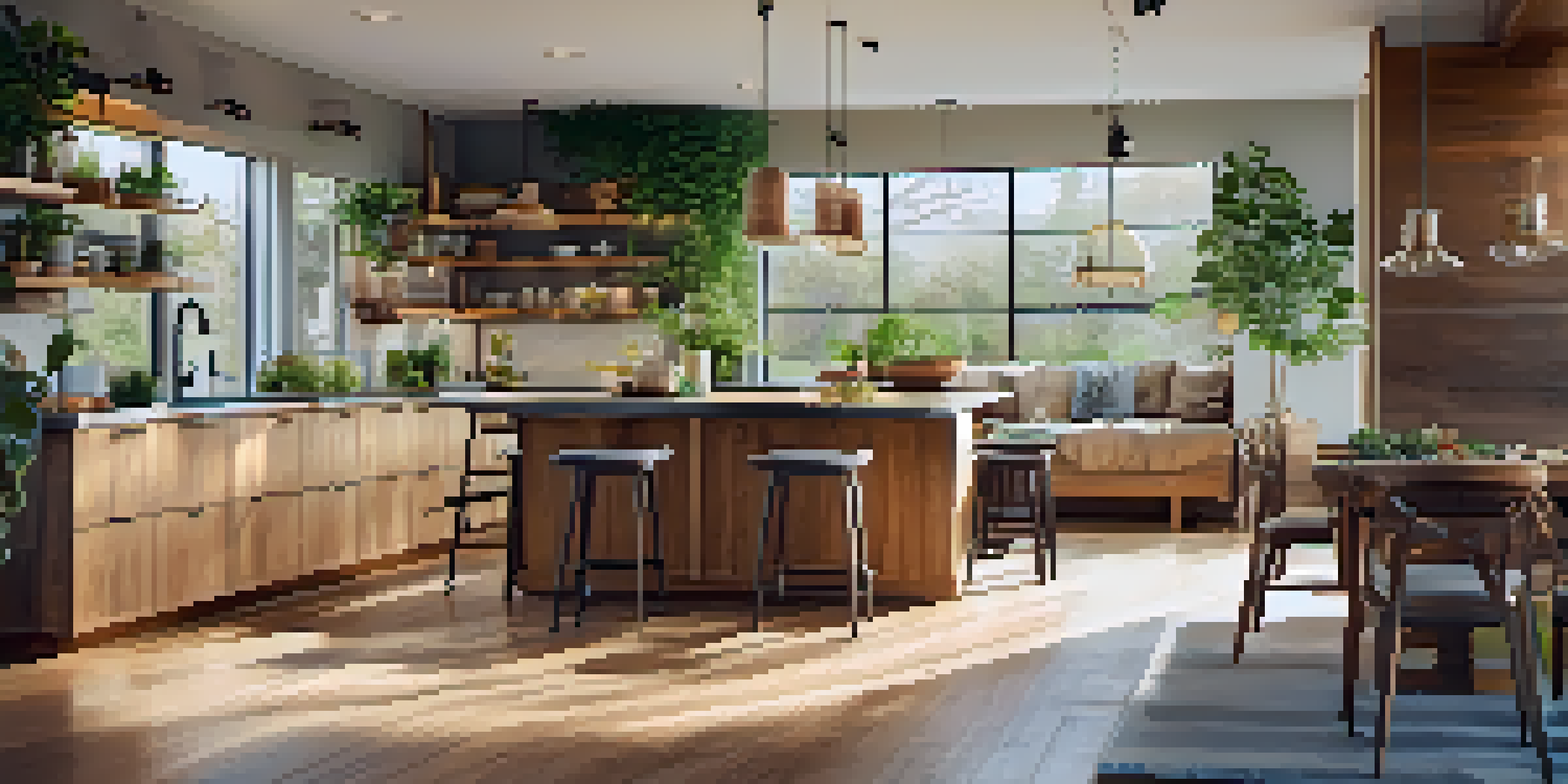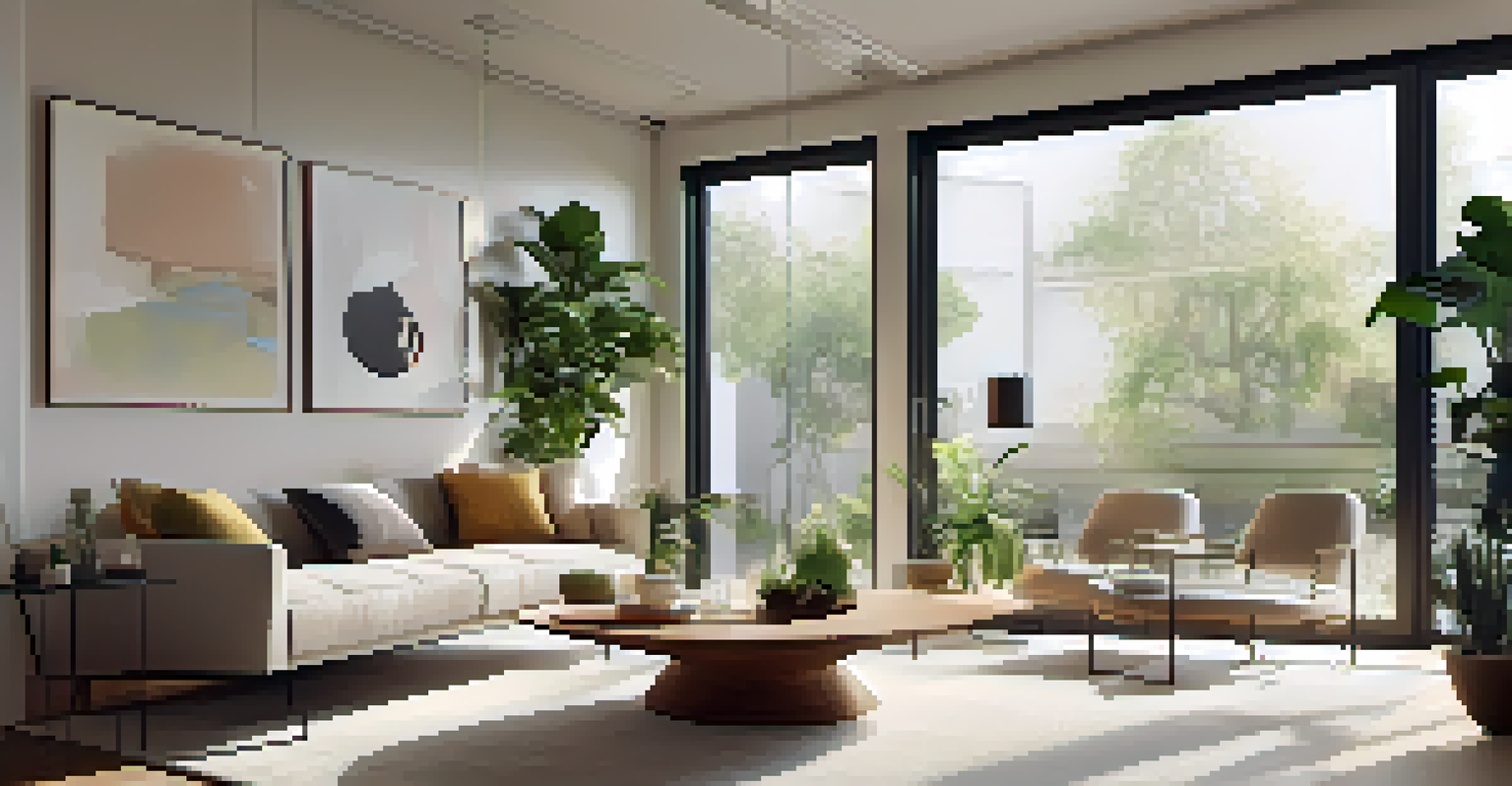The Future of Home Renovations: Trends to Anticipate

Sustainability Takes Center Stage in Home Renovations
As environmental awareness grows, homeowners are increasingly prioritizing sustainability in their renovation projects. This means using eco-friendly materials, energy-efficient appliances, and designs that minimize waste. For instance, reclaimed wood and recycled glass are becoming popular choices for flooring and countertops, offering both style and a reduced carbon footprint.
Sustainability is no longer a trend; it's a necessary part of our future.
Moreover, energy-efficient upgrades, such as solar panels and smart thermostats, not only help the environment but can also lead to significant savings on utility bills. Many homeowners are now viewing these upgrades as long-term investments rather than just costs. The shift towards sustainability is not just a trend; it's becoming a fundamental principle of modern home design.
This focus on sustainability encourages homeowners to think creatively about how they can reduce their impact on the planet. Whether it’s through choosing low-VOC paints or installing rainwater harvesting systems, every small change contributes to a larger goal of environmental responsibility.
Smart Home Technology: The Future is Here
The rise of smart home technology is revolutionizing how we think about renovations. Homeowners are increasingly looking to integrate smart devices that enhance convenience and security. Imagine controlling your lights, thermostat, and even your coffee maker from your smartphone—this is becoming the norm.

Smart home systems not only improve daily living but can also increase the value of a home. Features like automated lighting, smart security cameras, and even voice-activated assistants are appealing to tech-savvy buyers, making homes more marketable. Renovating with smart technology in mind can be a strategic move for homeowners looking to boost their property’s resale value.
Sustainability in Renovations
Homeowners are prioritizing eco-friendly materials and energy-efficient upgrades as a fundamental principle in modern design.
However, it’s essential to choose technology that seamlessly integrates with your home’s architecture and design. As you plan your renovations, consider how these smart features can enhance both functionality and aesthetics, ensuring they feel like a natural part of your living space.
Open Spaces and Functionality: The New Floor Plans
Gone are the days of compartmentalized rooms; open floor plans are here to stay. Homeowners are increasingly favoring layouts that allow for fluid movement between spaces, creating a more cohesive and inviting atmosphere. This trend is particularly popular in kitchens and living areas, where families gather and entertain.
The best rooms have something to say about the people who live in them.
An open concept not only enhances social interaction but can also make a space feel larger and more airy. By removing barriers, homeowners can create multifunctional spaces that adapt to their lifestyle needs. For example, a kitchen island can serve as both a cooking space and a casual dining area, maximizing utility without sacrificing style.
However, it’s crucial to balance openness with comfort. Thoughtful design elements, such as strategically placed furniture and lighting, can help define areas within an open space, ensuring it remains functional and aesthetically pleasing.
Biophilic Design: Bringing Nature Indoors
Biophilic design is gaining traction as homeowners seek to connect with nature within their living spaces. This approach incorporates natural elements such as plants, natural light, and organic materials to create a calming and restorative environment. Imagine waking up to a sunlit room filled with greenery—it’s not just a dream, but a trend that’s increasingly popular.
Incorporating biophilic elements can improve well-being and reduce stress, making it a desirable feature for renovations. Simple additions like indoor gardens, large windows, and natural wood finishes can transform a home into a serene oasis. As more people recognize the benefits of living in harmony with nature, biophilic design is set to become a staple in future renovations.
Smart Home Technology Gains Popularity
Integrating smart devices into homes enhances convenience and security while potentially increasing property value.
When planning your renovation, consider how you can integrate these natural elements into your design. Whether it’s through the use of plants, water features, or natural light, embracing biophilia can elevate your home’s atmosphere and enhance your overall quality of life.
Multi-Generational Living: Adapting Spaces for Everyone
As family dynamics evolve, more homeowners are embracing multi-generational living arrangements. This shift often requires renovations that accommodate various needs, from aging parents to young adult children returning home. Creating adaptable spaces is key to making everyone feel comfortable and at home.
Design elements such as separate entrances, private suites, and shared common areas are becoming essential in modern renovations. These features allow for independence while maintaining family connections, catering to different lifestyles and privacy needs. For example, a finished basement can serve as a private apartment for a relative, providing both autonomy and proximity.
When planning for multi-generational living, think about how spaces can be transformed to suit various functions. Flexibility in design will ensure your home can evolve with your family, making it a welcoming environment for all generations.
Embracing Minimalism: Less is More
Minimalism continues to influence home renovations, with homeowners opting for clean lines, uncluttered spaces, and a focus on quality over quantity. This trend encourages a more intentional approach to design, where every element serves a purpose and contributes to the overall aesthetic. Imagine a beautiful, serene space that feels open and organized—this is the essence of minimalist living.
Incorporating minimalism can also lead to practical benefits, such as easier maintenance and reduced stress. By decluttering and choosing fewer, high-quality pieces, homeowners can create a more harmonious environment. This trend doesn’t just apply to decor; it also extends to architectural elements, with many opting for simple yet elegant designs.
Embracing Open and Adaptable Spaces
Open floor plans and multi-generational living designs are becoming essential for creating functional and inviting home environments.
As you consider renovations, think about how minimalism can enhance both function and beauty in your home. By focusing on what truly matters, you can create a space that feels intentional, inviting, and refreshingly simple.
Color Trends: Bold and Unique Palettes
Color trends are shifting towards bold and unique palettes that reflect personal style and personality. Homeowners are moving away from neutral tones and are instead embracing vibrant hues that make a statement. This can range from deep jewel tones to unexpected accent walls that add character and warmth to any room.
Incorporating color into renovations can be a fun way to express individuality and creativity. Whether it’s through paint, wallpaper, or decor, choosing colors that resonate with you can transform a space and create a sense of belonging. For instance, a bright yellow kitchen can evoke feelings of happiness and energy, making it a delightful place to gather.

However, it’s essential to find a balance between boldness and cohesion. When experimenting with colors, consider how they work together throughout the home, creating a harmonious flow that reflects your unique style while still feeling cohesive.